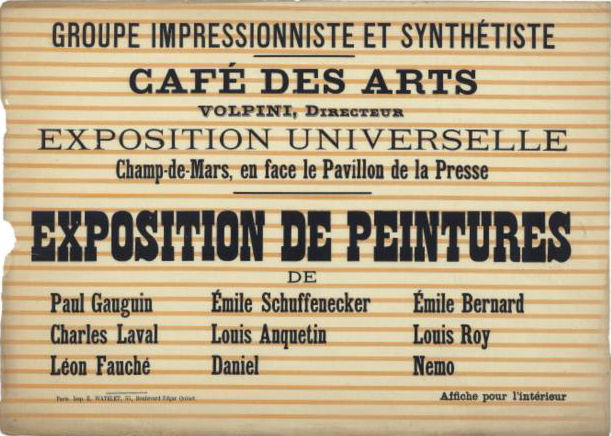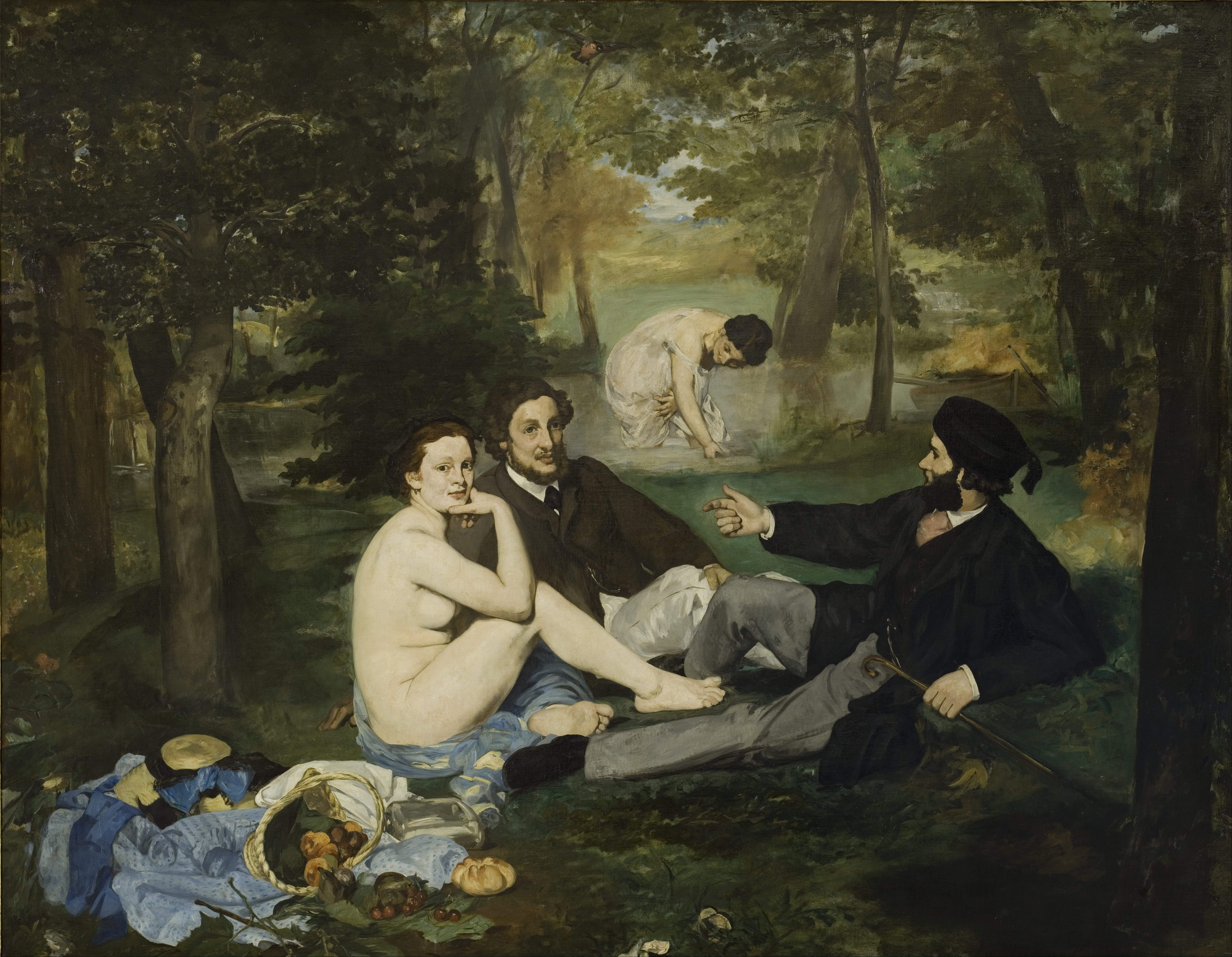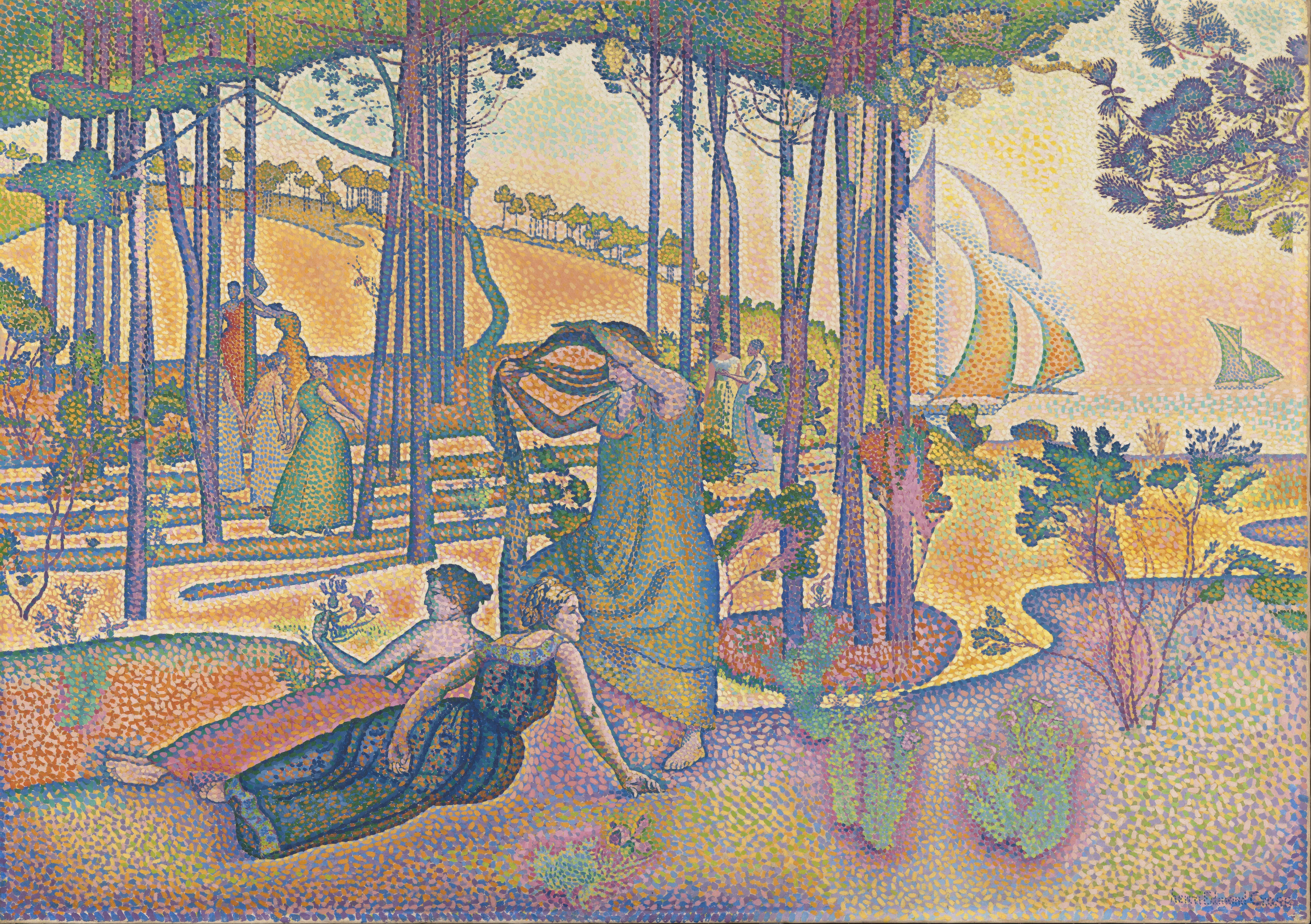|
Post-Impressionists
Post-Impressionism (also spelled Postimpressionism) was a predominantly French art movement that developed roughly between 1886 and 1905, from the last Impressionist exhibition to the birth of Fauvism. Post-Impressionism emerged as a reaction against Impressionists' concern for the naturalistic depiction of light and colour. Its broad emphasis on abstract qualities or symbolic content means Post-Impressionism encompasses Les Nabis, Neo-Impressionism, Symbolism, Cloisonnism, the Pont-Aven School, and Synthetism, along with some later Impressionists' work. The movement's principal artists were Paul Cézanne (known as the father of Post-Impressionism), Paul Gauguin, Vincent van Gogh and Georges Seurat. The term Post-Impressionism was first used by art critic Roger Fry in 1906.Peter Morrin, Judith Zilczer, William C. Agee, ''The Advent of Modernism. Post-Impressionism and North American Art, 1900-1918'', High Museum of Art, 1986 Critic Frank Rutter in a review of the Salon d'Automne ... [...More Info...] [...Related Items...] OR: [Wikipedia] [Google] [Baidu] |
Grafton Galleries
The Grafton Galleries, often referred to as the Grafton Gallery, was an art gallery in Mayfair, London. The French art dealer Paul Durand-Ruel showed the first major exhibition in Britain of Impressionist paintings there in 1905. Roger Fry's two famous exhibitions of Post-Impressionist works in 1910 and 1912 were both held at the gallery. History The date of foundation of the Grafton Galleries is not certain; some sources give 1873, when it had an address in Liverpool. The gallery was incorporated in London on 16 June 1891, and opened in February 1893 at 8 Grafton Street, with an extensive suite of rooms extending to Bruton Street. (The address was usually given as Grafton Street-Bond Street). The building was designed by John Thomas Wimperis (1829-1904) and William Henry Arber (1849-1904). The first manager was Francis Gerard Prange. By the early 1900s Venant Benoist, a French-born caterer working in Piccadilly, was the manager, and the buildings were let out for recepti ... [...More Info...] [...Related Items...] OR: [Wikipedia] [Google] [Baidu] |
Roger Fry
Roger Eliot Fry (14 December 1866 – 9 September 1934) was an English painter and art critic, critic, and a member of the Bloomsbury Group. Establishing his reputation as a scholar of the Old Masters, he became an advocate of more recent developments in French painting, to which he gave the name Post-Impressionism. He was an early figure to raise public awareness of modern art in Britain, and he emphasised the Formalism (art), formal properties of paintings over the "associated ideas" conjured in the viewer by their representational content. He was described by the art historian Kenneth Clark as "incomparably the greatest influence on taste since John Ruskin, Ruskin ... In so far as taste can be changed by one man, it was changed by Roger Fry". The taste Fry influenced was primarily that of the English speaking world, Anglophone world, and his success lay largely in alerting an educated public to a compelling version of recent artistic developments of the Parisian ava ... [...More Info...] [...Related Items...] OR: [Wikipedia] [Google] [Baidu] |
Frank Rutter
Francis Vane Phipson Rutter (17 February 1876 – 18 April 1937)"Rutter, Frank V. P.", ''Who Was Who'', A & C Black, 1920–2007; online edn, Oxford University Press, Dec 2007. Retrieved froukwhoswho8 August 2008. was a British art art critic, critic, curator and activist. In 1903, he became art critic for ''The Sunday Times'', a position which he held for the rest of his life.''The Times'', 19 April 1937, p. 16, issue 47662, col B, "Obituary: Mr. Frank Rutter". Retrieved froinfotrac.galegroup.com 8 August 2008. He was an early champion in England of modern art, founding the French Impressionist Fund in 1905 to buy work for the national collection, and in 1908 starting the Allied Artists Association to show "progressive" art, as well as publishing its journal, ''Art News'', the "First Art Newspaper in the United Kingdom". In 1910, he began to actively support women's suffragette, suffrage, chairing meetings, and giving sanctuary to suffragettes released from prison under the Cat ... [...More Info...] [...Related Items...] OR: [Wikipedia] [Google] [Baidu] |
Impressionism
Impressionism was a 19th-century art movement characterized by visible brush strokes, open Composition (visual arts), composition, emphasis on accurate depiction of light in its changing qualities (often accentuating the effects of the passage of time), ordinary subject matter, unusual visual angles, and inclusion of movement as a crucial element of human perception and experience. Impressionism originated with a group of Paris-based artists whose independent exhibitions brought them to prominence during the 1870s and 1880s. The Impressionists faced harsh opposition from the conventional art community in France. The name of the style derives from the title of a Claude Monet work, ''Impression, soleil levant'' (''Impression, Sunrise''), which provoked the critic Louis Leroy to coin the term in a Satire, satirical 1874 review of the First Impressionist Exhibition published in the Parisian newspaper ''Le Charivari''. The development of Impressionism in the visual arts was soon foll ... [...More Info...] [...Related Items...] OR: [Wikipedia] [Google] [Baidu] |
Camille Pissarro
Jacob Abraham Camille Pissarro ( ; ; 10 July 1830 – 13 November 1903) was a Danish-French Impressionist and Neo-Impressionist painter born on the island of St Thomas (now in the US Virgin Islands, but then in the Danish West Indies). His importance resides in his contributions to both Impressionism and Post-Impressionism. Pissarro studied from great forerunners, including Gustave Courbet and Jean-Baptiste-Camille Corot. He later studied and worked alongside Georges Seurat and Paul Signac when he took on the Neo-Impressionist style at the age of 54. In 1873 he helped establish a collective society of fifteen aspiring artists, becoming the "pivotal" figure in holding the group together and encouraging the other members. Art historian John Rewald called Pissarro the "dean of the Impressionist painters", not only because he was the oldest of the group, but also "by virtue of his wisdom and his balanced, kind, and warmhearted personality". Paul Cézanne said "he was a fa ... [...More Info...] [...Related Items...] OR: [Wikipedia] [Google] [Baidu] |
Paul Cézanne
Paul Cézanne ( , , ; ; ; 19 January 1839 – 22 October 1906) was a French Post-Impressionism, Post-Impressionist painter whose work introduced new modes of representation, influenced avant-garde artistic movements of the early 20th century and formed the bridge between late 19th-century Impressionism and early 20th-century Cubism. While his early works were influenced by Romanticism – such as the murals in the Bastide du Jas de Bouffan, Jas de Bouffan country house – and Realism (arts), Realism, Cézanne arrived at a new pictorial language through intense examination of Impressionist forms of expression. He altered conventional approaches to Perspective (graphical), perspective and broke established rules of Academic Art, academic art by emphasizing the underlying structure of objects in a composition and the formal qualities of art. Cézanne strived for a renewal of traditional design methods on the basis of the impressionistic colour space and colour modulation principl ... [...More Info...] [...Related Items...] OR: [Wikipedia] [Google] [Baidu] |
Neo-impressionism
Neo-Impressionism is a term coined by French art critic Félix Fénéon in 1886 to describe an art movement founded by Georges Seurat. Seurat's most renowned masterpiece, '' A Sunday Afternoon on the Island of La Grande Jatte'', marked the beginning of this movement when it first made its appearance at an exhibition of the Société des Artistes Indépendants (Salon des Indépendants) in Paris. Around this time, the peak of France's modern era emerged and many painters were in search of new methods. Followers of Neo-Impressionism, in particular, were drawn to modern urban scenes as well as landscapes and seashores. Science-based interpretation of lines and colors influenced Neo-Impressionists' characterization of their own contemporary art. The Pointillist and Divisionist techniques are often mentioned in this context, because they were the dominant techniques in the beginning of the Neo-Impressionist movement. Some argue that Neo-Impressionism became the first true avant-garde ... [...More Info...] [...Related Items...] OR: [Wikipedia] [Google] [Baidu] |
Impasto
Impasto is a technique used in painting, where paint is laid on an area of the surface thickly, usually thick enough that the brush or painting-knife strokes are visible. Paint can also be mixed right on the canvas. When dry, impasto provides texture; the paint appears to be coming out of the canvas. Etymology The word ''impasto'' is Italian in origin; in which it means "dough" or "mixture"; related to the verb , "to knead", or "to paste". Italian usage of includes both a painting and a impasto (pottery), potting technique. The root noun of is , meaning "paste". Media Oil paint is the traditional medium for impasto painting, due to its thick consistency and slow drying time. Acrylic paint can also be used for impasto by adding heavy body acrylic gels. Impasto is generally not used in watercolour, watercolor or tempera without the addition of thickening agent due to the inherent thinness of these media. An artist working in pastels can produce a limited impasto effect by pre ... [...More Info...] [...Related Items...] OR: [Wikipedia] [Google] [Baidu] |
Pointillism
Pointillism (, ) is a technique of painting in which small, distinct dots of color are applied in patterns to form an image. Georges Seurat and Paul Signac developed the technique in 1886, branching from Impressionism. The term "Pointillism" was coined by art critics in the late 1880s to ridicule the works of these artists, but is now used without its earlier pejorative connotation. The movement Seurat began with this technique is known as Neo-impressionism. The Divisionists used a similar technique of patterns to form images, though with larger cube-like brushstrokes. Technique The technique relies on the ability of the eye and mind of the viewer to blend the color spots into a fuller range of tones. It is related to Divisionism, a more technical variant of the method. Divisionism is concerned with color theory, whereas pointillism is more focused on the specific style of brushwork used to apply the paint. Pointillism is a technique with few serious practitioners today ... [...More Info...] [...Related Items...] OR: [Wikipedia] [Google] [Baidu] |
Realism (arts)
Realism in the arts is generally the attempt to Representation (arts), represent subject-matter truthfully, without artificiality, exaggeration, or speculative fiction, speculative or supernatural elements. The term is often used interchangeably with naturalism, although these terms are not necessarily synonymous. Naturalism, as an idea relating to visual representation in Western art, seeks to depict objects with the least possible amount of distortion and is tied to the development of linear perspective and illusionism in Renaissance Europe. Realism, while predicated upon naturalistic representation and a departure from the idealization of earlier academic art, often refers to a Realism (art movement), specific art historical movement that originated in France in the aftermath of the French Revolution of 1848. With artists like Gustave Courbet capitalizing on the mundane, ugly or sordid, realism was motivated by the renewed interest in the commoner and the rise of leftist polit ... [...More Info...] [...Related Items...] OR: [Wikipedia] [Google] [Baidu] |
Othon Friesz
Achille-Émile Othon Friesz (6 February 1879 – 10 January 1949), who later called himself Othon Friesz, a native of Le Havre, was a French artist of the Fauvist movement. Biography Othon Friesz was born in Le Havre, the son of a long line of shipbuilders and sea captains. He went to school in his native city. It was while he was at the Lycée that he met his lifelong friend Raoul Dufy. He and Dufy studied at the Le Havre School of Fine Arts in 1895-96 and then went to Paris together for further study. In Paris, Friesz met Henri Matisse, Albert Marquet, and Georges Rouault. Like them, he rebelled against the academic teaching of Bonnat and became a member of the Fauves, exhibiting with them in 1907. The following year, Friesz returned to Normandy and to a much more traditional style of painting, since he had discovered that his personal goals in painting were firmly rooted in the past. He opened his own studio in 1912 and taught until 1914 at which time he joined the army ... [...More Info...] [...Related Items...] OR: [Wikipedia] [Google] [Baidu] |









